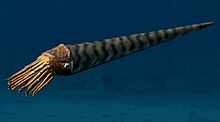Orthocerida
| Orthocerida Temporal range: Lower Ordovician–Upper Triassic |
|
|---|---|
 |
|
| Orthoceras | |
| Scientific classification | |
| Kingdom: | Animalia |
| Phylum: | Mollusca |
| Class: | Cephalopoda |
| Alliance: | Orthoceratoidea |
| Order: |
†Orthocerida Kuhn, 1940 |
| Families | |
|
Orthoceratidae (=Michelinoceratidae) |
|
Orthoceratidae (=Michelinoceratidae)
Geisonoceratidae
Proteoceratidae
Stereoplasmoceratidae
Clinoceratidae
Paraphragmitidae
Pseudorthoceratidae
Arionoceratidae
Lamellorthoceratidae
Orthocerida is an order of extinct Orthoceratoid cephalopods also known as the Michelinocerda that lived from the Early Ordovician (490 million years ago) possibly to the Late Triassic (240 million years ago). A fossil found in the Caucasus suggests they may even have survived until the Early Cretaceous (150 million years ago). They were most common however from the Ordovician to the Devonian.
The shell is usually long, and may be straight ("orthoconic") or gently curved. In life, these animals may have been similar to the modern squid, except for the long shell. The internal structure of the shell consists of concavo-convex chambers linked by a centrally-placed tube called a siphuncle. There is a tendency for the chambers to develop cameral deposits, which were used as ballast to balance the long gas-filled shell. Depending on the family, the siphuncle has orthochoanitic or cyrtochoanitic septal necks, which protrude from the septa. The shell surface may be (depending on the species or genus) smooth, transversely ribbed, or ornamented by a network of fine lirae. Fossils are common and have been found on many continents, including the Americas, Africa, Europe, and Asia.
...
Wikipedia
